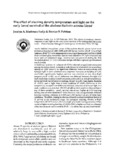The effect of stocking density, temperature and light on the early larval survival of the abalone Haliotis asinina Linné
Share
Abstract
Newly hatched trocophore larvae of the abalone haliotis asinina linne were stocked at densities of 1000, 3000 and 5000 larvae/1 at low (20-25oC) and high (ambien, 28-30oC) water temperature levels in light (transparent) and dark (black cloth-coered) lass container. Larvae were reared in UV light-irradiated sea water until pre-settement stage. Aeration was not provided during the 20-h incubation periond. A 3x2x2 factorial design with three replicates per treatment was folloed.
A three-way analysis of variance (ANOVA) showed a significant interaction among the factors tested. Analysis at each density level showed that at stocking density of 1000 larvae/1, no significant difference between temperatures and between light or dark condition was observed. However, at densities of 3000 and5000, significantly higher survival was obtained at low, than high temperature (P<0.05), but no difference between the light and darck conditions. Analysis at each temperature showed that, at high temperature,better survival was obtained at stocking density of 1000, than higher densities (P<0.001), and at light than at darck condition (P<0.05). However, at low temperature, no significant difference between light abd darck conditions was detected. ANOVA at light or darck condition showed that at any of these conditons, larvae survival was always higher at 1000 stocking density that t other density
(P 0.05). Survival was not significntly different between stockng density of 3000 and 5000 larvae/1 at any of those light conditions. Theredore, during incubation of newly hatched trocophore larvae of H. Asinina to pre-settlement stage, the optimum stocking density at high temperature (28-30oC) was 1000/1, in a light-penetrable rearing container. When reared at higherstocking densities of 3000 or 5000, a higher survival was obtained when temperature was lower to 20-25oC in either rearing conditions tested.
Suggested Citation
Madrones-Ladja, J. A., & Polohan, B. B. (2001). The effect of stocking density, temperature and light on the early larval survival of the abalone Haliotis asinina Linné. Phuket Marine Biological Center Special Publication , 25(1), 207-210. http://hdl.handle.net/10862/461


